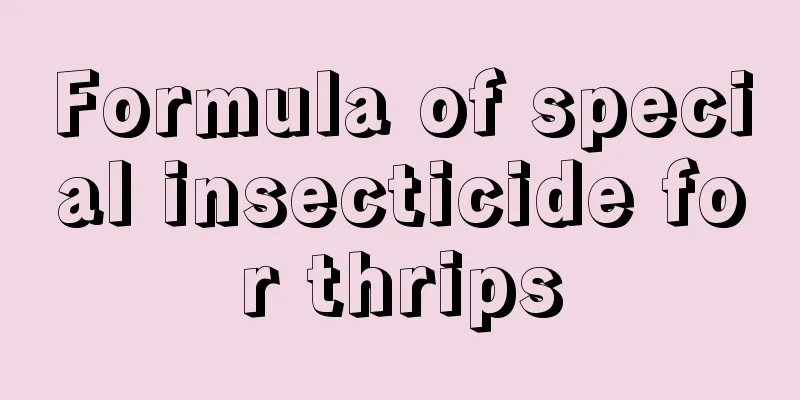Formula of special insecticide for thrips

|
Piercing-sucking pests such as aphids, whiteflies, whiteflies, and thrips have become important pests on many crops. They reproduce quickly, have many stages of insects, are easily resistant to pesticides, and are very difficult to control. Here we talk about the formula of special insecticides for thrips. 1. Formula of special insecticide for thrips Formula 1: 50% flubendiamide·spirotetramat water-dispersible granules (15% flubendiamide + 35% spirotetramat). This formula has a bidirectional conduction effect. Use 10-15 grams per mu and spray evenly. It can quickly control the damage of pests such as aphids, whiteflies, whiteflies, thrips, etc., and the effective period can reach more than 30 days. Formula 2: 60% flubendiamide·thiamethoxam water dispersible granules (20% flubendiamide + 40% thiamethoxam). This formula has stomach poison and contact killing effects. After application, the pesticide can be quickly absorbed by the roots or leaves of crops and has strong permeability in the plant body. Use 5-6 grams per mu, add 30 kilograms of water, and spray evenly. It has a good effect on pests such as aphids, whiteflies, and thrips. It has a longer lasting effect and better rain resistance. Formula three: 40% flubendiamide·ethylenediamine water dispersible granules (20% flubendiamide + 20% spinetoram) is the latest formula for controlling piercing-sucking pests. It can be used to control both piercing-sucking and chewing mouthparts pests on a variety of crops such as aphids, planthoppers, and diamondback moths. At the beginning of the pest outbreak, use 10-14 grams per mu, add 30 kg of water and spray evenly to quickly control the damage of pests. 2. Characteristics and harm of thrips Thrips are small insects, 1-2 mm long, usually yellow or green in colour. They usually hide on the back of plant leaves or in flowers and feed on the plant's sap, causing serious damage to the plant. Thrips can damage the cell tissues of plants, causing slow growth, leaf shrinkage, flower deformities, etc. In severe cases, it can even cause plant death. 3. Reasons why thrips are difficult to eliminate 1. Concealment: Thrips usually hide on the back of leaves or in flowers of plants and are difficult to detect. Even if it is discovered, it is difficult to completely eliminate it. 2. Strong reproductive ability: The life cycle of thrips is very short, usually only a few weeks, but they reproduce very quickly and can reproduce multiple generations a year, causing their numbers to increase rapidly. 3. Strong drug resistance: Many pests have developed resistance to drugs, and so have thrips. Some commonly used drugs have lost their effectiveness against thrips, and it is necessary to use higher-level drugs or change the prevention and control methods . 4. Good way to eliminate thrips 1. Physical control: Using yellow sticky boards or blue sticky boards to trap thrips is an effective method. Hang sticky boards above plants to capture thrips by attracting them to their color. This method is both environmentally friendly and safe, but it requires regular replacement of the sticky boards or cleaning of thrips on the sticky boards. 2. Biological control: Some natural enemy insects such as ladybugs and lacewings can prey on thrips, thereby reducing their numbers. Releasing these natural enemy insects in the garden is an effective control method. 3. Chemical control: Using appropriate chemicals is the fastest way to eliminate thrips. The drugs that can be selected include imidacloprid, acetamiprid, etc. When using drugs, you need to pay attention to the concentration and spraying method of the drugs to avoid contamination of plants and the environment. At the same time, attention should be paid to alternating the use of different drugs to avoid the development of drug resistance in thrips. 4. Agricultural prevention and control: Strengthening plant cultivation management, regularly pruning plants, removing weeds, etc. can improve the growth environment of plants and reduce the breeding of thrips. At the same time, it is also important to change different varieties of plants to avoid thrips developing a preference for certain plants. 5. Environmental regulation: Influence the reproduction and survival of thrips by adjusting environmental conditions. For example, increasing light and reducing humidity can inhibit the reproduction of thrips; increasing temperature can accelerate the growth and reproduction of thrips. Therefore, the number of thrips can be effectively controlled through reasonable environmental regulation. 6. Integrated prevention and control: The above methods can be used alone or in combination to form an integrated prevention and control system. For example, on the basis of physical control, appropriate chemical drugs can be used for emergency control; on the basis of agricultural control, biological control and environmental regulation can be combined to achieve better control effects. That’s it |
<<: How to take care of the newly bought crabapple
>>: How to care for newly bought lotus
Recommend
How often should orange trees be fertilized and what kind of fertilizer should be applied?
How often should you fertilize your orange tree? ...
What vegetables are suitable to grow in winter?
What vegetables are suitable to grow in winter? T...
How to trim the green treasure tree to make it look good
When is the right time to prune the green tree? I...
How to grow bougainvillea to make it bloom in summer?
Bougainvillea has a unique plant shape, emerald g...
When is the best time to transplant cedar?
For larger cedars, changing the planting area wil...
A 0.1-meter-long green ivy, placed here, can actually grow 100 meters!
If you place the green ivy here, it will take ove...
What flowers are easy to grow and suitable for home (what flowers are good-looking and easy to grow for beginners to plant at home)
When it comes to growing flowers, everyone wants ...
How to propagate cherry blossoms
1. Planting seeds Seeding is a relatively adaptab...
How to manage Dieffenbachia in winter
1. Adjust the temperature Variegated Dieffenbachi...
Where do rice seeds come from?
How do rice seeds come from? Rice is a seed plant...
The correct way to transplant and repot the fortune tree
Many people like to keep a few money trees at hom...
How to trim lavender
When to prune lavender It is generally better to ...
If the leaves of the lucky tree are turning yellow and falling off, water it with this water in summer and it will turn green in 3 days!
Yellow and falling leaves of the lucky tree 1. To...
Mulberry cutting time
1. Time Selection Both hard branches and green br...
How to plant the papaya seeds you just ate
1. Clean the seeds The seeds that have just been ...









